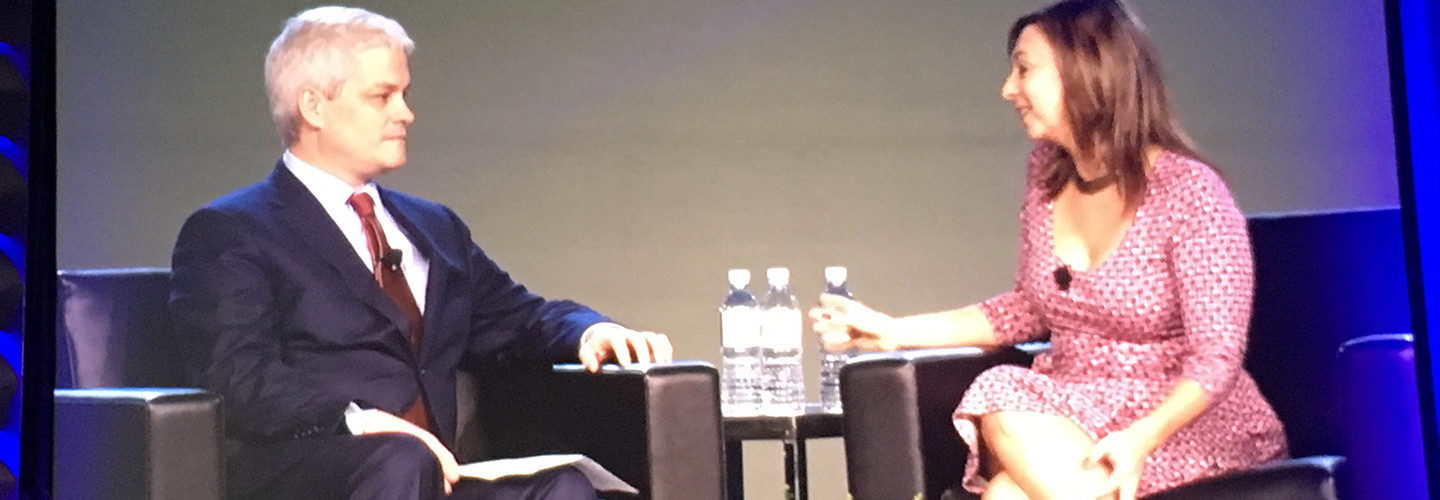EDUCAUSE 2016: Susan Cain on the Hidden Power of Introverts
In her opening keynote speech at the EDUCAUSE 2016 conference on Wednesday, author Susan Cain argued that misconceptions about introverts and extroverts often lead organizations to underestimate the value of solitude and independent thinking. As a result, they fail to maximize employee talent by not creating conditions where people can do their best work. Preconceptions about these personality types also affect the way teams collaborate and the types of individuals that organizations tend to identify as leaders, Cain said.
“We live in a cultural environment that is telling us implicitly and explicitly there is one style of leadership and one style of thinking deeply and creatively,” she said.
Cain is the author of Quiet: The Power of Introverts in a World That Can’t Stop Talking and Quiet Power: The Secret Strengths of Introverts, and the cofounder of Quiet Revolution, which works with schools and workplaces.
Introversion and extroversion — the way individuals respond to interaction, noise and other activity — are fundamental qualities that deeply affect the way we work and relate to other people, Cain said. The teams that perform best typically have a well-balanced mix of introverts and extroverts, along with ambiverts, who possess both types of traits. “We really need both styles in the room,” Cain said.
The Hidden Benefits of Being Quiet
Drawing from wide-ranging psychological research, Cain dispelled a few popular myths about introverts; for example, that they dislike teamwork and collaboration. In fact, she says, research has shown that many introverts are highly collaborative and focused on group outcomes. The catch? They do this best when they can do their deep thinking by themselves and then come back to the group to share their insights.
The differences between introverts and extroverts matter, Cain said, because they are not merely a preference for a particular style of work or interaction. Such traits are actually rooted in neurobiological differences: “We’re wired differently.”
One psychologist, Russell Geen, found that when introverts and extroverts were given math problems to solve with varying levels of background noise, the introverts performed much better with less noise, and vice versa. Such experiments have rich implications for workplaces, Cain said: “That is a profound bit of research for those of us who care about the way people work and thrive and innovate, because it’s telling us there’s no such thing as a one-size-fits-all situation.”
For individuals, knowing which mode best suits their own nature allows them to create working conditions that are most energizing and productive, she said.
Although popular conceptions often identify extroverts — those charismatic, outgoing, expressive individuals — as the best leaders, introverts have plenty of their own positive traits to offer, even if they might be less obvious. People who seem withdrawn and shy, for example, might be closely observing a situation, which allows them to pick up on subtleties and develop a more nuanced understanding of dynamics.
The challenge, Cain said, is that current thinking on teamwork and productivity often overlooks the importance of what introverts can contribute.
“I submit to you that we are living in an era right now that I call the new groupthink,” Cain said. “There is a new belief that creativity emerges from this very oddly gregarious place, that everything is the product of collaboration. While collaboration clearly is beneficial — we’re not talking about getting rid of collaboration — I am calling for more of a return to balance between collaboration and solitude.”
Experts who study creativity often find that the most accomplished individuals have enough of an introvert’s sensibility to enjoy solitude, a crucial ingredient in the deep reflection and independent thinking that is critical for creativity, Cain said.
Rethinking Conventional Workplace Practices
In organizations, lack of insight into these dynamics often leads to norms that may not yield the best outcomes. Brainstorming, for example, is typically considered a group activity, yet Cain pointed to extensive research showing that people generate better ideas when they brainstorm alone and then come back to share ideas with the group. That’s true, she said, for both introverts and extroverts.
Group dynamics — also well-established in psychology experiments — make people susceptible to the power of conformity. Without time alone, Cain argued, it is more difficult to achieve independent thinking, which is often the kind of innovation and creativity that organizations want most.
“If we want to get really good ideas, make our own decisions and have the courage of conviction behind those decisions, we have to at least some of the time give ourselves the solitude we need to come up with that stuff,” Cain said.
Organizations also fail to leverage the talents of introverts when they have a narrow idea of what a leader looks like and how a leader behaves, Cain said.
As an example, she pointed to Doug Conant, former CEO of Campbell Soup. Self-described as a reserved, modest person, Conant nevertheless managed to increase employee engagement at Campbell dramatically in his decade of leadership. One of his tactics? The quiet, simple act of writing letters of appreciation to individual employees. In all, he wrote 30,000 such letters — the act of an introvert, to be sure, but also an act that helped to boost engagement at Campbell Soup from almost nonexistent to extremely high.
Finding Ways to Work with Your Strengths
For EDUCAUSE attendees, Cain offered several takeaways, starting with the admonition to remove the word “networking” from their vocabularies. For an introvert, she acknowledged, such events only inspire dread. Instead, she said, view them as an opportunity to find “kindred spirits.”
She also encouraged listeners to step outside of their comfort zones — but to do so strategically. Although she is not an advocate for going against the grain of our natural tendencies, Cain said, she does encourage both introverts and extroverts to push themselves to expand their capabilities. That could mean recognizing the strategic benefit of activities that may feel uncomfortable or, for introverts, making sure after a busy day of meetings to schedule some alone time.
She also encouraged listeners to make an effort to identify individuals in their organizations who may not fit the conventional profile of a leader, but who just might have the qualities it takes to shine.
“How can you work with them to develop and step outside of their comfort zone?” she asked. “Many quiet people are extremely ambitious, but their ambition is often overlooked because people assume one doesn’t go with the other.”
Often, Cain said, small tweaks lead to big gains in how organizations develop talent and individual employees relate to each other. Simply recognizing that introvert/extrovert differences exist and talking about preferred work styles can go a long way toward helping teams be more creative and more effective.
To stay up to date on all of the news and ideas coming out of EDUCAUSE, follow EdTech's coverage on the EDUCAUSE 2016 conference hub.








